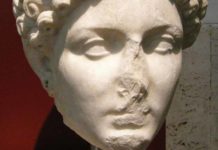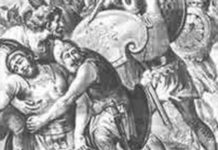Rome fancied celebrating its military conquests and victories. Victorious generals and legions would parade through the streets of Rome after an important battle, often to grand hoopla and celebration. Along with these processions, many commemorative monuments would be built to forever immortalize the grandeur that was Rome.
Triumphal arches were one type of monument that were used to commemorate significant events and individuals. Used in the Imperial era, these arches were enormous, and spanned a roadway that was adjacent to the location of some victorious march or procession that had occurred following an important triumph. Arches could be singular, having one central arch, or three-way, having a central arch and two smaller arches flanking it. The triumphal arch was ornately decorated with relief sculpture and Latin inscriptions that would have told the story of the triumph.
Arch of Augustus
To celebrate Augustus’ decisive victory over Cleopatra and Mark Antony at Actium in 31 B.C., this arch was erected. Little remains of the monument, which was built in A.D. 31, after the first Roman Emperor’s death. Its appearance can be estimated by depictions on Roman coinage, and it is known that it was a three-way arch (the first to be built in Rome), with the central arch vaulted. There are scant remains of the relief sculpture panels, which no doubt told the story of Augustus’ amazing defeat of the Egyptian Queen and her Roman lover, now housed in the Capitoline Museum in Rome.
Arch of Tiberius
The Arch of Tiberius is no longer standing today. Through literary evidence, it is known that while the arch was dedicated to Emperor Tiberius, Rome’s second Emperor, he had nothing to do with the triumph to which it is dedicated. The arch commemorates Germanicus’ recovery of the Roman standards in A.D. 15 from the Germanic tribes to the north. In Rome’s Imperial era, only Emperors were able to celebrate a triumph with an arch, thus it is the Arch of Tiberius, rather than the “Arch of Germanicus”.
Arch of Titus
This arch, located on the east side of the Forum Romanum, celebrates Emperor Vespasian’s and Titus’ victory in Judea in A.D. 70. This victory paved the way for the destruction of the temple at Jerusalem and the capture of the city. The arch was built in A.D. 81, after Titus’ death. This singular arch depicts the battle and the triumphal procession that was held in A.D. 71 through inscriptions and sculptural relief.
Arch of Septimius Severus
This arch was built in A.D. 203 to commemorate the victory of Emperor Septimius Severus over the Parthians in A.D. 195. This triumphal arch, still standing today, is located between the Curia and the Rostra. Its sculptural decoration depicts the Emperor’s victory in Parthia, telling the story in pictures of specific battles and their aftermaths.
Other important monumental and commemorative sites in the Forum Romanum celebrate Rome’s ancient history, and its commitment to religious ceremony.
Lapis Niger
Located near the Comitium, this monument was celebrated as the tomb of Romulus. A stone stela-like structure, it was topped with a large slab of black marble. This stela is marked with the oldest known Latin inscription, dating to around 550 B.C.
Umbilicus Urbis Romae
Literally “the navel of the city of Rome”, this was a monument in the Forum Romanum which designated the symbolic center of the city. It was located behind the Rostra.
Via Sacra
From the Latin for “sacred way” or “sacred road”, this was a through way for many religious and ceremonial processions. It also connected the religious monuments of the Forum Romanum.
Column of Phocas
Columns were used in the Imperial Era much like triumphal arches, to commemorate an individual or an event. This column dates very late in Rome’s history, to A.D. 608. Dedicated to Byzantine Emperor Phocas, this nearly 45-foot high Corinthian column was the last monument to be placed in the Forum Romanum.
Rome is known for its decisive military victories and political innovations. Just as important is their use of commemorative monuments to immortalize these events and the people involved, for there are many modern monuments that we can see today (Le Arc de Triomphe in Paris, for example) that took cue from the Ancient Romans.
Sources:
- Stambaugh, John E. The Ancient Roman City. Baltimore and London, The Johns Hopkins University Press, 1988.
- “Forum Romanum”. Retrieved from http://sights.seindal.dk/sight/4_Forum_Romanum.html








